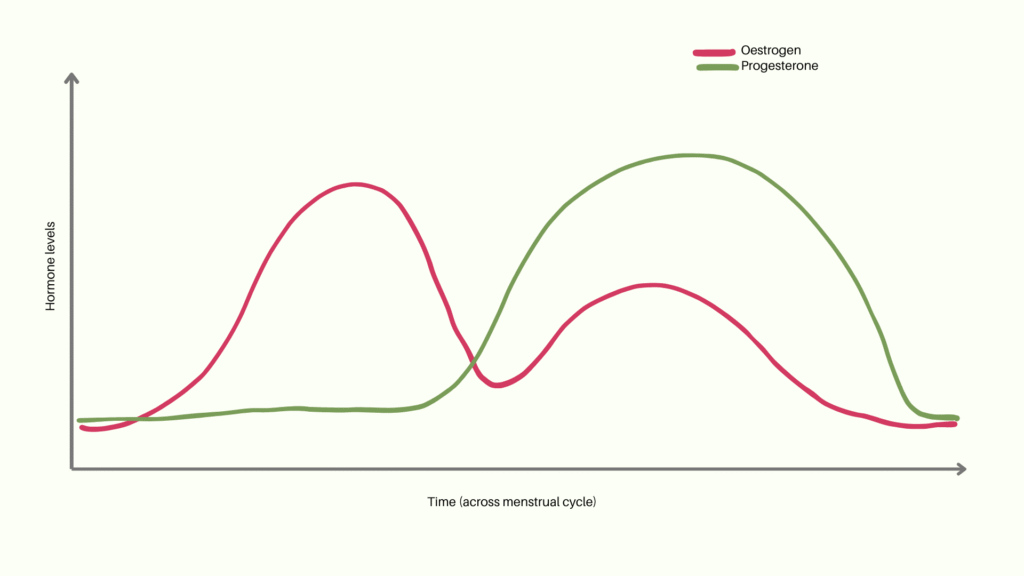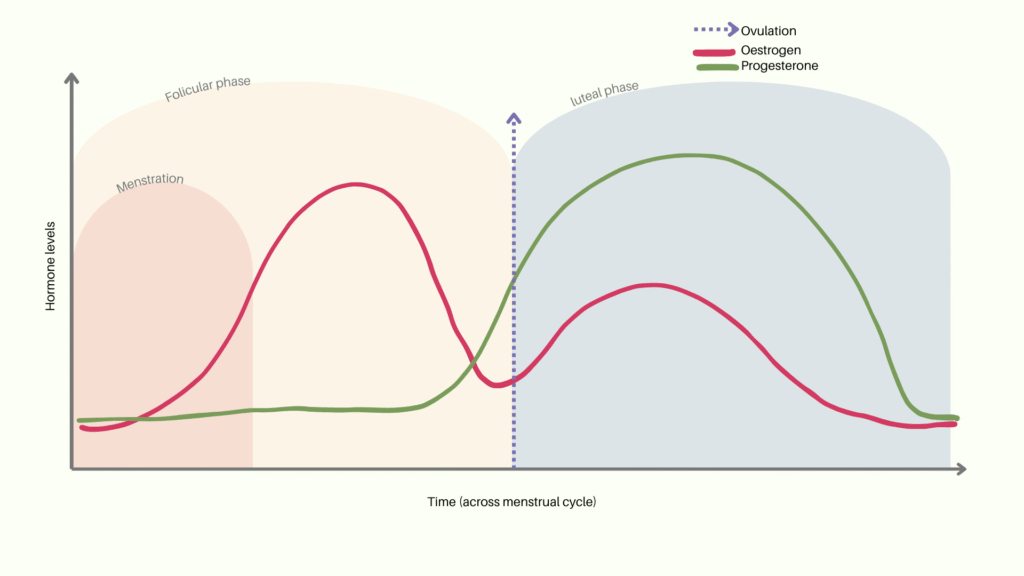Cycle syncing your workouts (tailoring your exercise routine to the phases of your menstrual cycle) is a new fitness trend that has gained popularity on social media recently. The idea is simple: you match your workouts to hormonal fluctuations throughout your cycle, doing high-intensity workouts during the follicular phase and slowing down during your luteal and menstrual phases.
But as a nutritional therapist who is passionate about evidenced based health, I want to know is it evidenced based? And is cycle syncing really necessary?
While it’s empowering to tune into your body, the trend of cycle syncing workouts could be overcomplicating movement, promote unnecessary restriction, and even hold women back from making consistent progress in their health and fitness goals. In this post, I’ll walk you through what cycle syncing is, where the science stands, and why your energy levels and personal preferences probably matter more than your hormone phase alone.
What is cycle syncing?
For those of us who menstruate, we know that our energy, mood, and even motivation can vary widely week to week due to fluctuating hormones. These hormones are there to send messages around your body, for their primary job of regulating ovulation (the release of an egg) and the menstrual phase (shedding of the uterine lining when pregnancy doesn’t occur).
These hormonal shifts result in 2 main phases: follicular (pre-ovulation) and luteal (which follows ovulation and ends when your next period begins). But when it comes to cycle syncing, this is often broken down even further into four distinct phases:
- Menstrual phase (your period)
- Follicular phase (rising estrogen, post-period energy boost)
- Ovulatory phase (peak estrogen and often peak energy)
- Luteal phase (higher progesterone, often more fatigue or sensitivity)


Cycle syncing is the practice of aligning your exercise style with the different phases of your menstrual cycle. The idea is that by adapting your movement to hormonal changes throughout the month, you can better support your body. Usually this is then linked to cortisol and the stress response.
Usually this is visualised in a circle split into four or some type of cycle image showing (for example) low-impact movement like stretching during your period, high intensity during ovulation, strength training in your follicular phase, and slowing down again before your next bleed.
It sounds plausible that your workouts might feel easier or harder depending on where you are in your cycle. And that’s the foundation many cycle syncing advocates build their recommendations on, but is there evidence to back it up?
Is there evidence for cycle syncing?
Despite the growing popularity of cycle syncing workouts, the scientific evidence behind tailoring your fitness routine to your menstrual cycle is, at best, limited. *However do bare in mind that women’s health and fitness is a greatly under funded, under researched subject and so that should of course be taken into account
In 2020 systematic review and meta-analysis (1), looking at strength and endurance performance across different phases of the menstrual cycle, found that exercise performance might be slightly reduced during the early follicular phase (i.e., the first few days of menstruation). However, this effect was so minor it’s unlikely to have a meaningful impact for most people (so if you’re not an elite athlete chasing every second for a PB).
More importantly, the researchers highlighted large inconsistencies between studies and noted that many were of poor quality. Because of this, they concluded that no generalised exercise guidelines can currently be made based on menstrual cycle phase alone. Basically, there’s not a one size fits all program to follow for your menstrual cycle.
Instead, the authors suggest a personalised approach, tracking how you feel as an individual and how you perform across your cycle, rather than rigidly following a random pinterest protocol based on hormone charts or generic templates.
So while it’s totally valid to feel different week to week, the evidence doesn’t support overhauling your entire training plan just because you’re in your luteal phase or menstruating. If anything, listening to your own energy levels, recovery, and motivation is likely more useful than forcing your workouts to match an idealised cycle syncing plan.
What are the cons of cycle syncing?
There might be a lack of good evidence showing any benefits, but is it harmful to cycle sync?
Women are not fragile
One of the biggest issues with overly structured cycle syncing as a blanket for everyone is that it subtly reinforces the idea that women need to be handled delicately when training. The truth? Women are f*cking powerful. And our bodies are designed to perform and thrive with working out across all phases of the menstrual cycle.
Very often these blanket cycle syncing routines suggest to do something gentle in both the luteal and the menstrual phase of your cycle. That can be a good 3 weeks for a lot of people!! Suggesting that we should take almost 3 weeks “off” intense exercise every month or only train hard during certain phases isn’t just inaccurate, it’s dis-empowering and detrimental to our health.
For years we’ve been scared to lift weights in case we get “too bulky” we’re finally almost past that stigma but cycle syncing might undo that work. Women are also at a higher risk for fractures later in life and guess what helps strengthen bones? Lifting weights… We need muscle for health and longevity. Muscle mass and grip strength are one of the best determiners of longevity and we are missing out on these if we are only working out properly half the time.
You Might Be Skipping Your Best Days
One-size-fits-all cycle syncing plans assume you’ll feel your worst during your period and your best around ovulation. But that’s not true for everyone. In fact, many people (myself included!) feel their most focused, grounded, or energised during menstruation. If I stuck to generic cycle syncing advice and kept things “light” just because I was bleeding, I’d be missing out on my best training days. Listening to your body matters more than following a template.
You Could Be Holding Yourself Back performance and aesthetic wise.
If you consistently scale back your workouts (especially resistance or strength training as mentioned above) for half of the month, you may see results much slower in both performance and physique goals. This is particularly true if you’re aiming for body re-composition, strength gains, and improving endurance. Your progress thrives on consistency. Not only are you possibly missing good days of workouts but also it’s much harder to get into a routine if you’re constantly changing it up.
Exercise can help with PMS and menstrual symptoms
Avoiding exercise during PMS or menstruation might feel intuitive, but the research actually shows that regular physical activity can reduce the severity of PMS and menstrual cramps (2). Imagine missing out on that benefit doing something supposed to support your female health!
Real-Life Cycle Variability
Not everyone has a textbook 28-day cycle with predictable hormonal phases. The Apple Women’s Health Study found that participants with regular cycles actually worked out more on average. Plus, anyone on hormonal birth control or in perimenopause won’t follow the same hormonal patterns, making cycle syncing plans irrelevant for lots of women.
What are the possible benefits?
Okay you’ve made your point Gina but are there any possible benefits even if we’ve not seen it yet in the research??
While cycle syncing shouldn’t be treated as a strict formula,I will absolutely admit there are a few benefits worth acknowledging; especially when it’s approached with nuance and self-awareness.
Cycle syncing can encourages rest and recovery awareness
One of the most valuable things cycle syncing can do is highlight the importance of rest and recovery. Many people push through every workout at 100% even when their body is crying out for a break. If cycle syncing encourages someone to pause and assess whether they’re overtraining, that’s a good thing
However, that self-check should happen on a day-to-day basis, not just because you’re in your luteal or menstrual phase. Rest is always valid but blanket rules aren’t always helpful. Maybe you need a break during ovulation because you didn’t get enough sleep…. and that is just as valid as taking it easy because you’re due on and feeling delicate.
Promotes body awareness
Following your cycle can be a helpful way to get out of your head and into your body. Learning how your body responds to different phases, foods, stressors, and workouts is always a good thing. This kind of self-tracking and reflection can be empowering and useful information as long as it doesn’t become restrictive. If cycle syncing encourages a deeper connection to your body’s signals, it can very well might enhance your long-term health.
Might support performance for some people
Some athletes or highly active individuals who feel noticeable changes in performance or motivation across their cycle might be able to tailor their training slightly. Like planning de-load weeks or adjusting intensity to improve recovery and consistency overall.
For example, I often (not always) use my luteal phase not as a time to retreat, but to push heavier weights with lower reps. This still supports progressive overload while respecting slight shifts in energy and focus. Here’s what my training might look like across the cycle:
- Menstrual: 12kg chest press – 8 reps x 3 sets
- Follicular: 12kg – 10 reps x 3 sets
- Ovulatory (highest energy): 12kg – 12 reps x 3 sets
- Luteal: 14kg – 8 reps x 3 sets
For endurance goals, the later luteal phase can be a great time to schedule a de-load week or focus on lower-intensity sessions like long, slow runs — not as a way to opt out, but to stay intentional about recovery as part of training, not in place of it.
Final thoughts: use it if it serves you. But, don’t let it limit you!
Cycle syncing sounds empowering, and for some, it can be. But in many cases, it unnecessarily over-complicates women’s fitness, creating rules and restrictions that our bodies don’t actually need.
The idea that we should slow down for (over) half the month can accidentally reinforce the myth that women are fragile and unable to be consistent holding us back from meaningful results.
That doesn’t mean the cycle is irrelevant. In fact, you can use your hormonal shifts strategically just in a more flexible and intelligent way. BUT YOU DO NOT HAVE TO.
Cycle syncing should never be a blanket rule for all people with periods. Some individuals who are burnt out and have been ignoring their body for years may genuinely benefit from using it to reconnect. But for most of us, the better strategy is to adjust where we need not at specific cycle phases.
Most importantly, don’t let it talk you out of showing up for yourself when you’re feeling strong!
- PMID: 32661839
- PMID: 38816591
- https://hsph.harvard.edu/research/apple-womens-health-study/study-updates/exploring-exercise-habits-by-menstrual-cycle-phase/#:~:text=While%20the%20idea%20of%20cycle,might%20not%20work%20for%20another.
